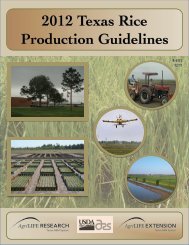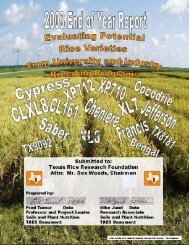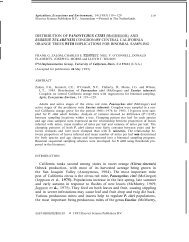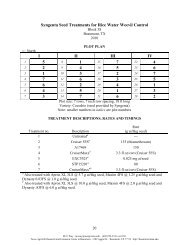2007 - Texas A&M AgriLIFE Research Center at Beaumont - Texas ...
2007 - Texas A&M AgriLIFE Research Center at Beaumont - Texas ...
2007 - Texas A&M AgriLIFE Research Center at Beaumont - Texas ...
You also want an ePaper? Increase the reach of your titles
YUMPU automatically turns print PDFs into web optimized ePapers that Google loves.
CL171-AR<br />
CL171-AR is a long-grain variety similar to Wells.<br />
Limited seed supplies will be available in <strong>2007</strong>. It offers<br />
good yield potential th<strong>at</strong> is equal to or better than CL161<br />
and has a high tolerance to Newp<strong>at</strong>h herbicide. CL171-AR<br />
has excellent seedling vigor and good standability. It is<br />
similar to CL161 in height and m<strong>at</strong>urity. Disease resistance<br />
is better than CL131 and CL161, and the variety appears to<br />
have more tolerance to she<strong>at</strong>h blight.<br />
CLXL8<br />
CLXL8 combines hybrid yield potential, Newp<strong>at</strong>h<br />
herbicide tolerance, disease resistance and straw strength<br />
to provide rice producers with high yield and outstanding<br />
red rice/weed control. CLXL8 is a long-grain with superior<br />
r<strong>at</strong>oon crop potential. CLXL8 meets industry milling<br />
standards.<br />
CLXL729<br />
CLXL729 was grown on limited acres in 2006 as<br />
CLXP729. It is a long-grain variety th<strong>at</strong> offers the high<br />
hybrid yield potential combined with Newp<strong>at</strong>h and Clearp<strong>at</strong>h<br />
herbicide tolerance. As with other hybrids, CLXL729<br />
is disease tolerant. It is 1 to 3 days earlier than other<br />
Clearfield varieties and has very good r<strong>at</strong>oon potential.<br />
CLXP729 is very easy to thresh and should be harvested as<br />
soon as grain moisture reaches acceptable levels. Milling<br />
yield is standard. It is similar to XL730 due to its resistance<br />
to blast and its moder<strong>at</strong>ely susceptibility to she<strong>at</strong>h blight.<br />
CLXL730<br />
CLXL730 was released on a limited basis as an experimental<br />
(XP730) hybrid in 2005. It is equivalent to CLXL8<br />
in grain yield as well as Newp<strong>at</strong>h tolerance and disease<br />
resistance, but has better milling yield. It is a long-grain<br />
variety with average straw strength and excellent r<strong>at</strong>oon<br />
crop potential. CLXL730 is very easy to thresh and should<br />
be harvested as soon as grain moisture reaches acceptable<br />
levels. It is resistant to blast and moder<strong>at</strong>ely susceptible to<br />
she<strong>at</strong>h blight.<br />
Cocodrie<br />
Cocodrie was developed by the Louisiana Agricultural<br />
Experiment St<strong>at</strong>ion from a cross of Cypress/L202/Tebonnet.<br />
It is a semidwarf, long-grain variety th<strong>at</strong> flowers about<br />
a week l<strong>at</strong>er than Jefferson. Main crop yields have been<br />
excellent and generally better than other cultivars. Although<br />
other cultivars may exceed it in r<strong>at</strong>oon crop yields and<br />
milling quality, Cocodrie continues to be a very stable<br />
and strong performing cultivar. This variety has improved<br />
resistance to blast disease similar to th<strong>at</strong> of Jefferson, but is<br />
considered moder<strong>at</strong>ely susceptible to she<strong>at</strong>h blight disease.<br />
Cybonnet<br />
The University of Arkansas released Cybonnet in 2003.<br />
It was developed from a cross of Cypress/Newbonnet/K<strong>at</strong>y,<br />
and is similar to Cocodrie in yield, height and m<strong>at</strong>urity. It<br />
has excellent milling quality like Cypress and broad spectrum<br />
resistance to blast disease like K<strong>at</strong>y. It is moder<strong>at</strong>ely<br />
susceptible to she<strong>at</strong>h blight disease.<br />
Francis<br />
Francis is a long-grain cultivar released in 2002 by<br />
the University of Arkansas. It was developed from a cross<br />
using Lebonnet, Dawn, Starbonnet and LaGrue as parents.<br />
Francis’ main crop yields and m<strong>at</strong>urity are similar to those<br />
of Cocodrie. It is 4 to 5 inches taller than Cocodrie and<br />
has consistently lower milling yields. It is susceptible to<br />
all races of blast and like LaGrue is moder<strong>at</strong>ely resistant to<br />
she<strong>at</strong>h blight disease.<br />
Jefferson<br />
Jefferson is a very early m<strong>at</strong>uring, semidwarf, long-grain<br />
variety developed <strong>at</strong> <strong>Beaumont</strong> from the cross Vista/Lebonnet/Rosemont.<br />
Although the main crop yields of Jefferson<br />
are not as high as Cocodrie, its r<strong>at</strong>oon crop yield is superior<br />
to most other cultivars. Because of its earlier m<strong>at</strong>urity, the<br />
likelihood of harvesting a full second crop is very good.<br />
Milling yields of Jefferson tend to be better than Cocodrie,<br />
but lower than Cypress and Saber. Seedling vigor of Jefferson<br />
is not as strong as Cocodrie. Because of the larger grain<br />
size of Jefferson and lower tillering abilities, higher seeding<br />
r<strong>at</strong>es may be needed to achieve adequ<strong>at</strong>e panicles per unit<br />
area. An important advantage of Jefferson is its disease<br />
resistance. It has one of the best combin<strong>at</strong>ions of blast and<br />
she<strong>at</strong>h blight resistance of any semidwarf rice variety.<br />
Presidio<br />
Presidio was developed from a cross of Jefferson, Maybelle<br />
and Rosemont. It is a long-grain variety th<strong>at</strong> is similar<br />
in m<strong>at</strong>urity and height to Cocodrie. Its main crop yield is<br />
lower than Cocodrie, but its r<strong>at</strong>oon crop potential averages<br />
35 percent higher than Cocodrie. Presidio has excellent<br />
milling quality, similar or better than Cocodrie. Presidio<br />
inherited broad-spectrum blast resistance and moder<strong>at</strong>e<br />
susceptibility to she<strong>at</strong>h blight disease from Jefferson <strong>at</strong> a<br />
level th<strong>at</strong> is likely to preclude the use of fungicides in most<br />
circumstances.<br />
Saber<br />
Saber is a semidwarf, conventional long-grain cultivar<br />
th<strong>at</strong> was developed <strong>at</strong> <strong>Beaumont</strong> from the cross Gulfmont/<br />
RU8703196/Teqing. Main crop yields of Saber are similar<br />
to Jefferson, but lower than Cocodrie. Its height, m<strong>at</strong>urity<br />
and r<strong>at</strong>oon crop potential are similar to Cocodrie. Saber has<br />
very high and stable milling quality like th<strong>at</strong> of Cypress.<br />
Saber possesses improved resistance to blast disease th<strong>at</strong> is<br />
comparable to Jefferson and improved resistance to she<strong>at</strong>h<br />
blight disease th<strong>at</strong> is better than other semidwarf commercial<br />
cultivars.<br />
Spring<br />
Spring is a semidwarf, long-grain variety developed<br />
by the University of Arkansas. It is very early m<strong>at</strong>uring,<br />
averaging 5 days earlier than Cocodrie. It has good seedling<br />
vigor and is about 4 inches taller than Cocodrie. Because of<br />
its early m<strong>at</strong>urity, it should be closely managed to optimize<br />
yield and milling quality. It has broad-spectrum resistance<br />
to blast disease. Although it is susceptible to she<strong>at</strong>h blight,<br />
it may escape she<strong>at</strong>h blight pressure because of its earliness.<br />
–––––––––––––––––––––––––––––––––––––––––––––––––––––––––––––––––––––––––––––––––––––
















